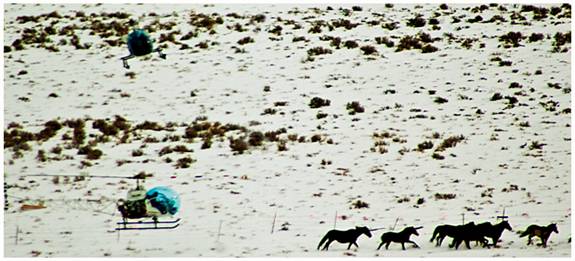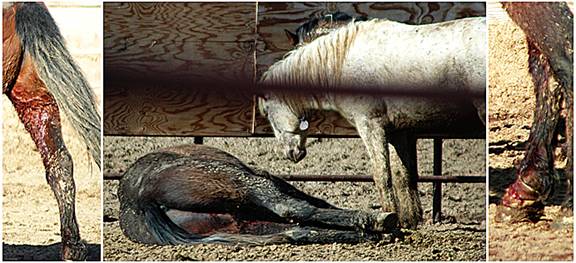Wild Horse - Bureau of Land Management Roundups
In February of 2010, LCA's Special Investigations Unit (SIU) traveled to the mountains of Northwest Nevada to investigate and document the roundup of wild horses by the Bureau of Land Management (BLM). During the course of the investigation into the Calico roundup, investigators videotaped wild horses being chased through the snow by several loud, menacing helicopters.
The stallions, mares, and foals were terrified as they were herded across the rocky landscape into holding pens, where they were immediately separated from one another. After being captured by the government the equine families were ripped apart. The SIU went to the Palomino adoption facility and the Fallon holding facility to see what conditions these magnificent, proud, wild horses were being forced to endure.
The horses, including young foals, did not have any access to shade or cover in order to escape the elements. These facilities are in Nevada where temperatures reach into the 120’s during the summer and sub-freezing during winter. Icy cold winds whip through the facilities but the horses had no way to escape the elements. They were forced to stand in the mud of their own feces and urine. The SIU saw numerous foals and horses with bloody hooves. As a result of the roundup, 68 horses were directly killed. In addition, over 30 mares aborted their nearly full-term foals.
The BLM’s stated reason for removing the wild horses was because they were starving or soon would be. As can clearly be seen in the video, not a single one of the horses being rounded up is starving or even thin. The facts belie the BLM’s statements. The SIU also saw other wild horses out in the same area and did not see a single one who looked to be in any kind of distress. In fact, the only horses they saw who were injured were those that had become so due to the BLM’s ill-advised roundup.
In 1971, Congress passed The Wild Free-Roaming Horses and Burros Act, which required the protection, management, and control of wild free-roaming horses and burros on public lands. Congress found and declared that wild free-roaming horses and burros are living symbols of the historic and pioneer spirit of the West; that they contribute to the diversity of the life forms within the Nation and enrich the lives of the American people' and that these horses and burros are fast disappearing from the American scene.
Congress, with overwhelming public support, intended for wild horses and burros to be protected in the wild, and removed only when necessary, and if removed, guaranteed humane treatment. They were never to be sold for slaughter. It is the policy of Congress that wild free-roaming horses and burros shall be protected from capture, branding, harassment, or death; and to accomplish this they are to be considered in the area where presently found, as an integral part of the natural system of the public lands.
Since its inception in 1971, The Bureau of Land Management's (BLM) and the U.S. Forest Service’s (FS) Wild Horse and Burro Program have failed to protect the horses and burros they are responsible for. Unfortunately, the BLM operates in a manner that promotes the interests of the livestock industry and other commercial operations over those of wild horses and burros. As a result, wild horse and burro populations and their herd areas have dramatically declined in number and size; the BLM has taken away 20 million acres of wild horse habitat and removed over 270,000 horses from the range.
The "multiple use management concept" included in the 1971 Act has been construed by the BLM to allow multiple uses of public lands on Herd Management Areas. The Act states that herd areas are to be “devoted principally” to the welfare of the wild horses and burros. “Multiple use” was intended to support and maintain a "thriving natural ecological balance" on public lands, with respect to other wildlife and range biology and ecology. The BLM includes under “multiple use” such uses as cattle grazing, mining, development, and oil drilling. Such uses were not intended to justify the removal of wild horses and burros from their herd areas.
To make matters worse, in November 2004, without a hearing or an opportunity for public review, Senator Conrad Burns from Montana, slipped a rider into the 2005 Federal Appropriations Bill amending the 1971 Wild Free-Roaming Horse and Burro Act. The Burns amendment authorized “sale authority” for the BLM and FS and since then, the “Burns Bill” allowed the majority of horses being held in government pens to be rounded up, removed and even sold for slaughter.
The BLM Roundups
 BLM’s helicopter roundup
BLM’s helicopter roundup
Photo: LCA’s Special Investigations Unit
Helicopters, with deafening blades, terrorize and force herds of frightened wild-free-roaming horses to gallop for their lives, not realizing they are being herded to a corral where they will be forever removed from their native land. As a result of the roundups, some of the horses become bloodied, injured, exhausted and some mares miscarriage their colts. Others simply die in the process.
 Horses injured during the BLM roundups
Horses injured during the BLM roundups
Photo: LCA’s Special Investigations Unit
LCA’s Special Investigation Unit witnessed the inhumane way in which the wild horses are gathered, herded and transported at the biggest FY 2010 BLM “Calico Roundup” in Gurlock, Nevada. The roundup is intended to roundup approx 2,500 horses and leave just 600 horses on approx 542,000 acres of this range complex. The family structure of these horses is torn apart. As the horses are herded into the trap, the stallions are separated from the mares and the foals from their mothers. The horses are shipped to another facility where they stand, their spirits broken and all life erased from their eyes, in their own waste with no escape from the elements. These iconic creatures of the Wild West will never see their grazing lands again or their family.
Although the BLM claims the horses are “starving” or malnourished, none of the horses rounded up or in the holding pen are emaciated or unhealthy looking. The BLM admits they cannot give the horses the diet they are used to in the wild and some horses get sick from the feed they are given.
 Injured horses from the BLM roundup
Injured horses from the BLM roundup
Photo: LCA’s Special Investigations Unit
Cost to Taxpayers
The cost to taxpayers annually is over $60 million dollars. The Obama Administration proposes to spend up to 500 million tax dollars to purchase private lands in the Midwest and East to warehouse wild horses removed from public lands (which the taxpayers already own) in the West. The cost to taxpayers annually for government holding facilities is over $60 million dollars.
What the public is not being told is that the Cattlemen with their millions of cows are getting subsidized grazing rates for their herds at the expense of taxpayers and the wild horses. Additionally, cattle are an invasive species that are much more devastating to the ecosystem than the horses. Wild horses are a small percentage of grazing animals on public lands, where they are outnumbered by cattle at least 200 to 1.
The Survival of Wild Free-Roaming Horses is in Jeopardy
The wild horse population today is smaller than in 1974 when the BLM conducted the first census after Congress protected the horses due to their dwindling numbers. The BLM says that there are approximately 33,000 horses left in the wild. There are more horses in government holding facilities than on the range. The interests of these living “historic and pioneers spirits of the West” are being forfeited for those of the livestock industry and other commercial operations. The truth is there are too few horses and burros on our public lands and unless the wild horse numbers are allowed to grow, the survival of these amazing animals is in jeopardy.
What You Can Do:
• CLICK HERE to find your elected officials' contact information and urge them to stop the BLM's mismanagement of burros and wild horses.
• Please watch the investigative report from CBS's George Knapp: "Stampede to Oblivion" and share this online video with everyone.

Jillian Michaels lends her image to LCA’s Stop the BLM Roundups Campaign
![]() Learn more about: Horses - Premarin
Learn more about: Horses - Premarin
